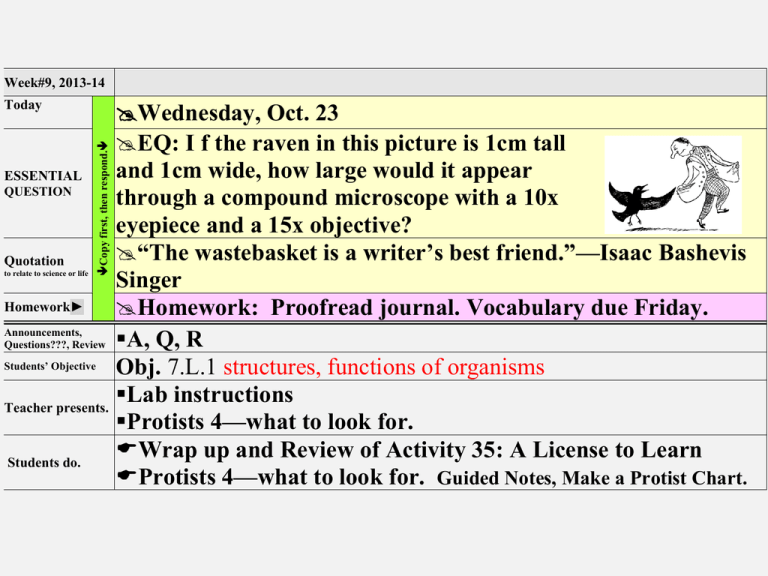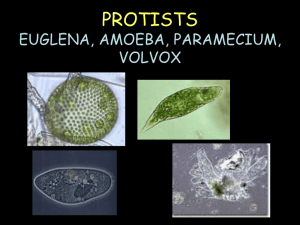PROTISTS EUGLENA, AMOEBA, PARAMECIUM, VOLVOX
advertisement

Week#9, 2013-14 ESSENTIAL QUESTION Quotation to relate to science or life Copy first, then respond. Today Homework► Announcements, Questions???, Review Students’ Objective Teacher presents. Students do. Wednesday, Oct. 23 EQ: I f the raven in this picture is 1cm tall and 1cm wide, how large would it appear through a compound microscope with a 10x eyepiece and a 15x objective? “The wastebasket is a writer’s best friend.”—Isaac Bashevis Singer Homework: Proofread journal. Vocabulary due Friday. A, Q, R Obj. 7.L.1 structures, functions of organisms Lab instructions Protists 4—what to look for. Wrap up and Review of Activity 35: A License to Learn Protists 4—what to look for. Guided Notes, Make a Protist Chart. PROTISTS 4+ EUGLENA, AMOEBA, PARAMECIUM, VOLVOX What is a protist? Use your Guided Notes handout with this slideshow. • Protist—an organism from the Kingdom Protista • Very diverse group of single-celled organisms. • Eukaryotic (They have nuclei.) • ` Common Protists Draw the table. Use a full page. 5 columns, 5 rows. Protist Name Euglena Amoeba Paramecium Volvox Sketch Movement Food source (Energy) Special Features EUGLENA • Single-celled Protists= that lives in fresh water. • Captures food by eating other organisms • Has chlorophyll • ` More Info on Euglena • Eyespot helps it sense light. • Waste- Contractile vacuole collects excess water then squirts it out of the cell. • Movement by a flagella • video More Info on Euglenas • Reproduction- -asexual (binary fission) • Special features- shape changes easily so it can move around • ` AMOEBA • Found in freshwater and salt water around a lot of dead and decaying material. • Hunter • Can be parasite in humans • ` More Info on Amoebas • Waste- Contractile vacuole squirts out excess water • Movement- The cell shapes itself into pseudopods (false feet) – made by cytoplasmic streaming • amoeba video Amoeba • Reproduction- - asexual (binary fission)` PARAMECIUM • Found in freshwater. • This is a complex singlecelled organism. • Cilia sweep food into food passageway. • VIDEO ` Paramecium Continued… • Waste- – Anal Pore (food waste is removed) – Contractile Vacuole (water waste removed) • Movement- cilia (tiny hairs that move back and forth.) – Cilia also sweep food into the oral groove and gullet` Notice the cilia covering my entire body! Paramecium Continued… • Reproduction- sexual (two parents) • Special feature- two nuclei (macronucleus and micronucleus) • ` VOLVOX • Found in ponds ditches and puddles. • Composed of a colony of more than 50,000 tiny cells • Often called algae. • ` Volvox continued… • photosynthesis and flagella help bring in nutrients. • Eyespots sense light. • ` Volvox continued… • Movement- Many flagella help move the colony. • Reproduction- asexual and sexual, daughter colonies created.` Volvox Videos volve. Watch them re • video 1 • video 2 Common Protists Protists Groups Features Sketch Movementand Food Special Protist Draw Table below on Page ? source (Energy) Euglena Amoeba Paramecium Volvox Features Common Protists Protist Sketch Movement Food source (Energy) Specialized Features Protists Groups and Features Flagellum Unicellular Pseudopods Feeds on other organisms Unicellular Cilia Feeds on other organisms Lives in colonies Flagella Makes its own food by photosynthesis Euglena Amoeba Paramecium Volvox Feeds on other organisms; Also makes its own food by photosynthesis Unicellular Eyespot Oral groove and contractile vacuole Volvox The Red Section • Recap / review • Other than this slide, please write down anything that is in RED. • ` Euglena • • • • • Moves by a flagellum eye spot Contains chloroplasts Common in fresh water No cell wall so it can change shape.` Euglena • Found in calm fresh and salt water • Used as a model organism in the lab • Autotroph – gets energy via photosynthesis • Heterotroph —also gets nourishment heterotrophically like animals • Has features of both plants and animals • Kingdom Protista` Amoeba • Moves by cytoplasmic streaming • Surrounds food and engulfs it using pseudopods. The food is then stored and digested in vacuoles.` Amoeba • • • • • • Changes shape drastically Heterotrophic Eats bacteria, algae, and other protists Reproduces asexually Can become dormant (cysts) Can survive forcible division` Paramecium • Most complex and specialized of the protists • Moves by cilia (hair-like projections)` Paramecium • Fast--Can move about 12 body lengths per second • Shape of a pill capsule • Heterotrophic • Relatively large • Common in pond scum and freshwater • Has two nuclei (macro and micro)` Paramecium • Uses cilia to sweep food into the oral groove • Feeds on micro-organisms like bacteria, algae, and yeasts • Is covered in cilia so it spirals through water` Volvox • A spherical colony of up to 50,000 cells • Contains chloroplasts • The colony revolves •Moves and acts as one multicellular organism but one cell can survive independent of the colony` Volvox • Type of green algae • freshwater – ponds, ditches, puddles, lagoons • Colonies use flagella to swim • Cells have eyespots • Makes food by photosynthesis • End of red section` Quiz Be sure you have the correct answers in your guided notes!!! Which unicellular organisms move by flagella? A. B. C. D. Euglena Amoeba Paramecium Volvox Euglena and Volvox Which unicellular organism moves by cilia (hair-like projections)? A. Euglena B. Amoeba C. Paramecium D. Volvox Paramecium Which single-celled organism uses pseudopods to surround and engulf food? A. Euglena B. Amoeba C. Paramecium D. Volvox Amoeba Which organism is a colony of flagellates with chlorophyll? A. Euglena B. Amoeba C. Paramecium D. Volvox Volvox Which single-celled organism has an eye spot? A. Euglena B. Amoeba C. Paramecium D. Volvox Euglena Which colonial organism has eye spots? A. Euglena B. Amoeba C. Paramecium D. Volvox Volvox Which single-celled organism moves by cytoplasmic streaming? A. Euglena B. Amoeba C. Paramecium D. Volvox Amoeba Which organisms can have chlorophyll? A. Euglena and Amoeba B. Amoeba and Paramecium C. Paramecium and Volvox D. Euglena and Volvox Euglena and Volvox Which organism appears in all the photos in this slide? • paramecium Read the diagram. Be able to answer the questions on the following slide! What engulfs the food? A. cytoplasm B. pseudopods C. vacuoles D. nucleus pseudopods What digests the food? A. cytoplasm B. pseudopods C. vacuoles D. nucleus vacuoles A nucleus B cytoplasm Name the parts located at A and B. The End • Really.






